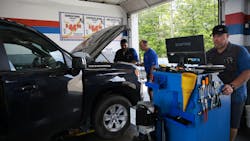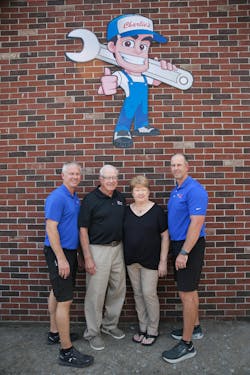With a network of seven Charlie’s Fast Lube shops across Missouri and Illinois, as well as five full tire and automotive centers, business is humming along nicely for owners Brian and Jason Glueck.
The company employs about 100 team members in total, including 40 at its fast lube locations. Those oil change shops, mostly located in rural markets, average between 20 and 50 vehicles serviced per day.
At the center of the operation, Brian Glueck keeps tabs on the health of his business through an in-house KPI-tracking system. The platform has been refined and developed significantly in the past five years, and it’s a far cry from where Glueck’s father, Charlie, began when he opened his first tire and auto shop in Jackson, Missouri, in 1980.
“In my years growing up, Dad’s No. 1 KPI was, ‘Is there money in the bank to pay the bills?’ That was it. That’s all he tracked,” Brian Glueck says. “For him to have an idea, even with the lube shop, of how many air filters we were doing a week or a month or anything, we just didn’t have that. It was more a question of am I making money or not? Can I survive until tomorrow?”
Brian Glueck speaks from first-hand experience, as he began helping around the shops at a young age.
“Growing up in the industry, you get roped into work,” Glueck says. “Even at a young age—10 or 12 years old—he started us in the quick lube with vacuuming cars, checking tire pressures, that sort of thing.”
These days, now as a second-generation business owner, Glueck finds himself checking numbers that are a bit more complex than tire pressure levels. When asked about the KPIs he is tracking across all his locations, Glueck rattles off a lengthy list.
“We’ve got all the basic things that I think most operators are going to track,” he says. “You know they’re going to look at your sales. They’ll look at car counts and ticket averages, and then look at that percentage relative to your car count of air filters and cabin filters and different things you service. We have about 13 different things that we offer that we track relative to a percentage of car count to give us a good idea of what that is.
“Along with that, we also try to look at labor percent to net sales. There are a few other things like that we track as well.”
While many quick lube operators have enlisted the services of an outside vendor or software to assist with data tracking and analysis, the operation at Charlie’s is homegrown. Over the past five years, spreadsheets have been developed internally to foster collaboration between locations with regards to metrics.
“Our point-of-sale is not directly incorporated into QuickBooks,” Glueck says. “(The store managers) do a lot of data entry at the end of the day. They fill out a spreadsheet that is hosted on the cloud. And they fill out that sheet every day from their point-of-sale. What did I sell today? How many of this? How many of that? How many cars? That gets uploaded and brought here internally.”
Glueck credits Cody Hinkebein, a district manager, for taking the data that is uploaded by store managers and weaving it into a comprehensive report that shows the financial health of the organization overall.
“He’s done a nice job with that,” Glueck says. “It makes things easier to see.”
Striking Gold
As the Charlie’s team has developed its KPI-tracking procedures, Glueck says his focus has not been on adding more metrics to track, but rather better connecting the dots between those that the company has already been monitoring. For the core 13 items offered in addition to basic quick lube services—referred to internally as “BTIs” (big-ticket items)—Hinkebein has built spreadsheets to keep tabs on sales relative to car counts.
“How many BTIs did I sell relative to car count today? That’s a metric I look at a lot,” Glueck says. “I know it doesn’t mean a lot to other owners because they don’t have ‘BTIs,’ but basically, what percentage of (customers) are we selling extra services to? Is that 40%, 30%, 50%? Where is that metric?”
Responsibilities for BTIs at Charlie’s are also divided and assigned to specific job functions within the shop. Hood technicians are responsible for one group of products/services, while a pit technician has responsibility for other add-ons.
“That makes it easier to identify areas that need some extra training,” Glueck says. “If you see a tendency at one store or all the stores that they’re lacking in one particular thing, then maybe that’s a training focus for us. Those kinds of collaborations are what I would say have helped more so than any (singular item) tracking. It’s being able to put it together and see trends better.”
Car counts and BTI percentages are among the metrics that Glueck considers his “golden KPIs.”
“I look at that BTI percentage because when I see a dip and it gets down in that 20% to 30% range, I know we’ve got a process issue with that store, and we need to get involved and see what’s going on.
“On the same side, when we see that same thing trending in the other direction and it’s up closer to 50%, that’s also a red light for me. We’re not here to oversell or offer things to a guest that they don’t need. We have that happy medium there.”
Tracking the Intangibles
While building an efficient metrics platform has helped Glueck keep his business profitable, there is one KPI he especially values, and it isn’t found on any of his spreadsheets.
“More than tracking any of the stuff, I would say my No. 1 KPI that’s not on paper is what’s the overall atmosphere of the store when you walk in? What’s the morale?” he says. “You can instantly feel it when you go in, and a store is clicking. The manager is engaged. He’s upbeat. He’s positive, and his crew is, too. That store, you can look at their sales, and those are going to follow it.”
It's a two-way street, Glueck adds. A store with a gloomy atmosphere and an unhappy manager is more likely to deliver lackluster service to guests and have uninspiring sales to match.
“That’s probably my biggest thing,” he says. “When I visit with my district managers, what’s your overall feel of that store right now, aside from any numbers. This is what’s going to dictate the numbers.”
Glueck’s Guide to KPI Tracking
For operators looking to refine their data collection practices, Glueck offers the following tips:
Carve out time to get it done, whether you hire someone to focus specifically on data tracking or have an existing employee double up on responsibilities. For Glueck, it’s the latter, with Hinkebein serving as both a data analyst and district manager.
Either way, Glueck says, “you have to create and make time to do it. If you don’t have the data, you’re kind of the blind leading the blind.”
Keep it simple, and focus on tracking data that is actionable. “One of the big things I’ve learned along the way is don’t track anything you’re not going to use,” Glueck says. “You can get lost in the sauce pretty quick and think you need to track everything out there. ‘We’ve got to track every single item from this year, and how does that relate to last year, and the year before, and to this store, and…’
“Don’t get lost in the sauce. Don’t create busy work and track things you have no intention of doing anything with.”
Invest in what you can afford. Glueck recalls a recent meeting he had with fellow quick lube operators. Tracking bay times became a hot topic of conversation, with attendees marveling at one operator’s elaborate, high-tech setup.
“(Bay times are) something we all want to track. I want to track that, but it’s expensive to buy all the cameras. And then you have to have somebody in your organization that’s going to extract that and put it to use,” Glueck says.
“We’re all blown away by what (the operator with the bay time tracking setup) is able to do, but he’s like, ‘Look, don’t get lost in this stuff. You can track data all day long. But just being in the stores and around the stores and having that general atmosphere is worth more than any of these numbers.’”
About the Author
Tom Valentino
Editor
Tom Valentino is the editor of National Oil and Lube News. A graduate of Ohio University, he has more than two decades of experience in newspapers, public relations and trade magazines, covering everything from high school sports to behavioral health care. Tom’s first vehicle was a 1990 Mazda 626, which he used to deliver pizzas in the summer after graduating high school. Today, he drives a 2019 Jeep Compass, which usually has a trunk full of his daughter’s sports gear. In his spare time, Tom is an avid Cleveland sports fan and a volunteer youth sports coach.
Don't miss Tom Valentino's next article. Sign up for NOLN's Quick Lube Report and This Month in NOLN newsletters.



